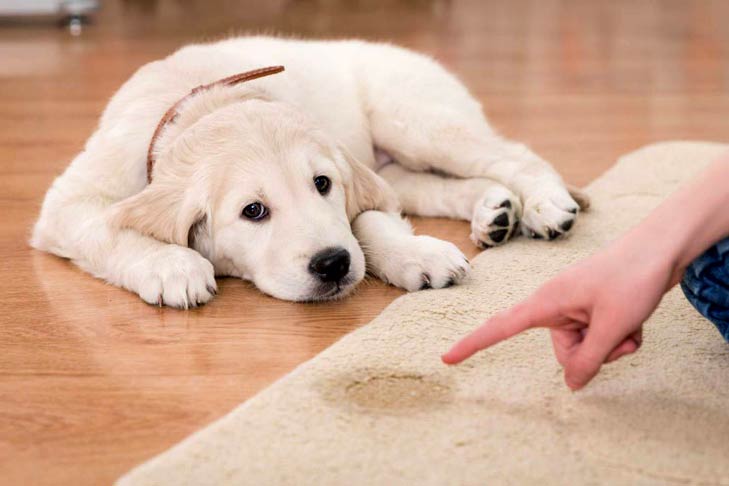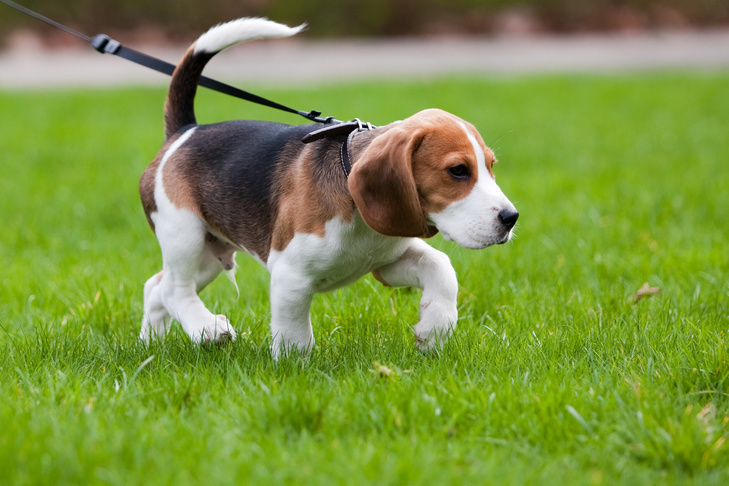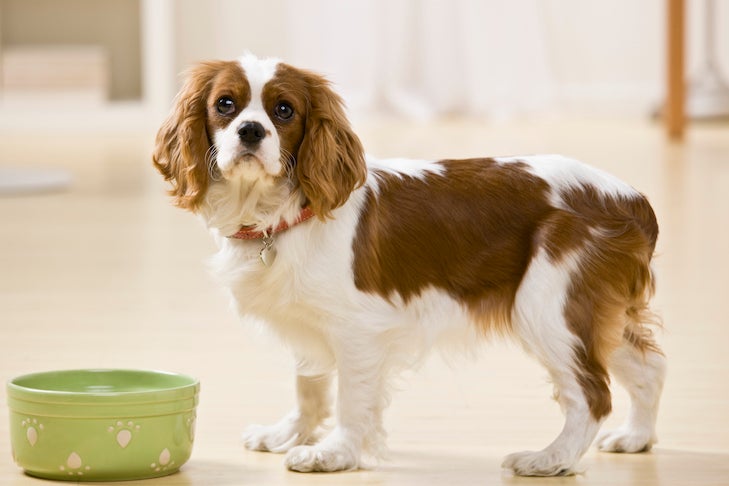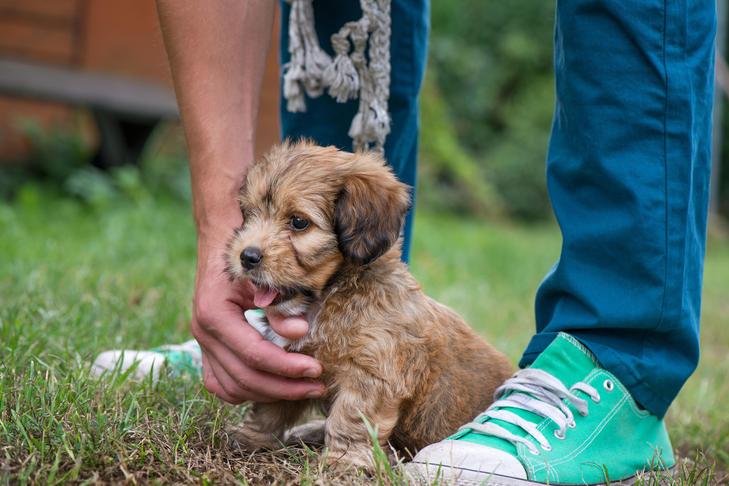AKC is a participant in affiliate advertising programs designed to provide a means for sites to earn advertising fees by advertising and linking to akc.org. If you purchase a product through this article, we may receive a portion of the sale.
Learning how to potty train puppies at the right time and place is one of the most important first steps you can take for a long, happy life together. House soiling is among the top reasons why dogs lose their homes or end up in shelters. Few people are willing to put up with a dog who destroys rugs and flooring, or who leaves a stinky mess that needs to be cleaned after a hard day at work.
That’s why it’s so important to make sure that you do some research in advance on how to house train a dog, decide what will work best for your situation, and make a plan.
There are tried-and-true methods for training your puppy, says Mary Burch, Ph.D., director of the AKC’s Canine Good Citizen and S.T.A.R. Puppy programs. While she says there are pros and cons to each, they all can be successful if you follow a few basic tips.
Crates Rank High as a Potty Training Tool
Many people who are new to dogs cringe at the idea of confining their puppies in a crate, but the reluctance to use this tool generally evaporates after a few days of living with a new pet. Dog crates make life easier. It’s a good idea to get your dog accustomed to one for many reasons, such as vet visits or traveling.
Dogs are den animals and will seek out a little canine cave for security whether you provide one or not. That makes it relatively easy to train your dog to love their crate.
The principle behind using a crate for housetraining is that dogs are very clean creatures. They don’t like a urine-soaked rug in their living spaces any more than you do. It’s important that the crate is the right size — just large enough for the dog to lie down, stand up, and turn around. If it’s too large, the dog will feel that it’s OK to use one corner for elimination and then happily settle down away from the mess. Many crates come with partitions so you can adjust the size as your puppy grows.
When they feel an urge, a puppy will usually let you know by whining and scratching. That’s their signal that they have to go and want out of their little den. Now! If you let your dog lose control in their crate, they’ll get the idea that it’s OK to mess up their living space. Then they’ll think nothing of leaving little packages around where you live, too.

Using Puppy Pads and Paper Training
Dr. Burch says the use of puppy pads and paper training can be tricky. “You’re reinforcing two different options for the puppy,” she explains. In an ideal situation, puppies would learn to hold it indoors and only eliminate at specific spots outdoors. But some cases may require a bit of creative thought, such as a person who has a job that makes it impossible to get home several times a day, or for a tiny dog living where the winters are brutal. Puppy pads give a dog the option of relieving themselves in an approved spot at home. There are also indoor dog bathrooms that even work for male dogs. After the dog matures, the owner can then work on having the dog do their business outdoors all the time.
Create a Housetraining Schedule for Your Puppy
Keeping a consistent housetraining schedule is critical to success. Puppies have tiny bladders, and water runs right through them. The same is true for solid matter. You have to make sure you’re giving your puppy ample opportunity to do the right thing.
A good guide is that dogs can control their bladders for the number of hours corresponding to their age in months up to about nine months to a year. Remember, though, that 10 to 12 hours is a long time for anyone to hold it! A 6-month-old puppy can reasonably be expected to hold it for about 6 hours. Never forget that all puppies are individuals and the timing will differ for each.

Monitor daily events and your puppy’s habits when setting up a schedule. With very young puppies, you should expect to take the puppy out:
- First thing in the morning and last thing at night
- After playing indoors
- After spending time in a crate or upon waking up from a nap
- After chewing a toy or bone, eating, or drinking
This could have you running for the piddle pad, backyard, or street a dozen times or more in a 24-hour period. If you work in-person, make some kind of arrangement to keep that schedule. It can be helpful to have a dog walker or a person familiar to your dog stop by your home to take them out to go potty.
The quicker you convey the idea that there is an approved place to potty and that some places are off-limits, the quicker you’ll be able to put this messy chapter behind you.
Observing and Supervising Your Dog
You have to watch your puppy carefully for individual signals and rhythms. Some puppies may be able to hold it longer than others, while some will have to go out every time they play or get excited. Others will stop in the middle of a play session, pee, and play on. As with human babies, canine potty habits are highly idiosyncratic.
Controlling Your Dog’s Diet
Puppies have immature digestive systems, so they can’t really handle a lot of food. That’s why it’s recommended that you break up the puppy feeding schedule into three small meals. Another thing to keep in mind is the food itself, which should be the highest quality puppy food. Whatever you choose, make sure it agrees with your puppy.
Examining a dog’s stool is the best way for an owner to figure out whether it’s time for a change in diet. If your puppy is consistently producing stools that are bulky, loose, and stinky, it may be time to talk to your vet. They might recommend switching to a new dog food. Overfeeding may also provoke a case of diarrhea, which will only make the task of housetraining that much more difficult.

Reinforcing Your Puppy for “Going” Outside
Scolding a puppy for soiling your rug, especially after the fact, isn’t going to do much. Likewise, some old methods of punishment, like rubbing a dog’s nose in their poop, are so bizarre that it’s hard to imagine how they came to be and if they ever worked for anyone. Praising a puppy for doing the right thing works best for everything you will do in your life together. Make them think that they’re a little canine Einstein every time they perform this simple, natural act.
Be effusive in your praise — cheer, clap, throw cookies. Let them know that no other accomplishment, ever, has been as important as this pee. Reward your puppy with one of their favorite treats. Make sure they’re nice and small, easy for your puppy to digest.
If your dog has an accident, don’t make a fuss, just clean up the mess, advises Dr. Burch. Use a cleaner that eliminates odors to remove the scent, so the dog won’t use it in the future. Blot up liquid on the carpet before cleaning the rug.
If you catch the dog starting to squat to urinate or defecate, pick them up and immediately rush outside. If they do the job outdoors, give them plenty of praise and attention. Remember that when it comes to housetraining, prevention is key.

Troubleshooting Common Housetraining Problems
Following these rules will usually result in a well house-trained puppy. But sometimes, it doesn’t go as planned.
Dr. Burch notes that sometimes house soiling is a sign of a physical issue. “Well before the several month mark, a dog who has seemed impossible to housetrain should have a good veterinary workup,” she says. If your vet finds that your dog is healthy, the next step is to find a trainer or behaviorist who has had experience with this issue.
Here are some common complaints that trainers say they have encountered:
“My Dog Is Piddling All Over the House!”
This is common among people who own toy dogs. Some trainers recommend teaching puppies to use indoor potty spots, similar to how a cat uses a litter box. In addition to piddle pads, there are actual dog potty boxes for indoor use. Trainers say that with consistency, you can house train a little dog. It just may take a little additional time, attention, and effort.
“My Dog Keeps Peeing in the Same Spot Where They Had an Accident.”
That’s probably because you didn’t clean up the mess efficiently. There may still be some odor there, signaling that this is a prime potty spot. In your new puppy supply kit, make sure you have plenty of pet stain enzymatic cleaners and carefully follow instructions on using them.

“I Gave Them the Run of the Apartment. When I Came Home, There Was a Mess.”
This is a common mistake among dog owners. They see some early signs that the dog is getting the idea, and declare victory too soon. Even when the puppy is consistently doing what you want, keep to the schedule to make sure the good habits are ingrained.
“They’re Soiling Their Crate!”
Dr. Burch says dogs who come from situations where they were confined for long periods and had no other choice but to eliminate in their kennels will often soil their crates. The best approach would be to go back to square one with crate and house training. Here are the steps to follow:
- Assess how well your dog can control their bladder and bowels when not in the crate
- Carefully control their diet and schedule
- Give frequent trips outside, including after every meal, first thing in the morning, and last thing at night
- If you work, consider hiring a dog walker
- Clean everything so there are no odors left
How Long Does Puppy Potty Training Take?
How long you’ll need to work on potty training can vary considerably, says Dr. Burch. There are many factors to consider, such as age, learning history, and your methods and consistency. An 8-week-old puppy is very different developmentally than a 5-month-old puppy. Some puppies have perfect manners after just a few days. Others can take months, especially if the dog has had a less than ideal situation before coming to you. With patience and persistence, though, most dogs can learn.
At AKC Marketplace, we can help you find your dream dog. You can find AKC-registerable puppies from responsible, passionate breeders, and we provide the tools you need for every step of the process. Visit marketplace.akc.org to start connecting with dog breeders in your area!

